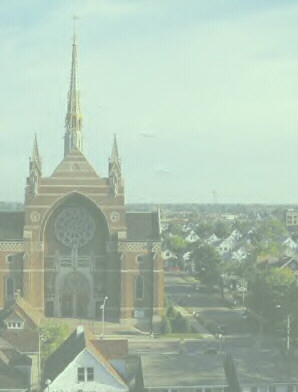Hamtramck
Wayne County
Michigan
The origin of the name, Hamtramck, has been confused a number of times, some have thought it was a Polish word, some a varation of tamarack (a well-known and populus tree in Michigan), however, it really came from Colonel John Francis Hamtramck, a French-Canadian soldier, who was born in Quebec, and found his way into the United States Army during the Revoluntionary War.
Hamtramck served under General Anthony Wayne, and members of his staff during the surrender of Detroit from the British on July 11, 1796. After the war, he built himself a home near the present entrance to the Belle Isle Bridge. When he died in 1803, he was buried in the old church yard of Ste. Anne's. Later his body was removed to the new site on Bates Street and finally interred in Mt Elliott Cemetery. The lettering on his gravestone became so worn, that in 1928, the Catholic Study Club of Detroit, restored the monument, which reads as follows:
"Sacred to the memory of John Francis Hamtramck, Esq., Colonel of the U. States Regiment of Infantry, and Commandant of Detroit and its Dependencies. He departed this life on the 11th of Ap 1803, Aged 48 years, 7 months, and 28 days. True patriotism and a zealous attachment to national liberty, joined to a laudable ambition, led him into military service at an early period of his life. He was a Soldier before he was a Man. He was an active participator in all the dangers, difficulties and honors of the Revoluntionary War; and his heroism and uniform good conduct procured him the Attention and Personal Thanks of the Immortal Washington. The United States in him have lost a Valuable Officer and a Good Citizen, and Society an Useful and Pleasant member. To his family the loss is incalculable, and his Friends will never forget the memory of Hamtramck. This humble monument is placed over his Remains by the Officers who had the honor to serve under his Command-a small by grateful Tribute to his Merit and his Worth."
When the county was organized and given the name of Wayne, and equal propriety was given a rural township a little north of Detroit, named Hamtramck.
In 1901 the area called Hamtramck was incorporated into a village and in 1922, it attained the status of city.
The earliest occupants of the area were the French, who's names of settling men can be found on the names of the streets within the city. Joseph Campau, DeQuindre, St. Aubin, and Dubois all reflect the presence of the French. But of the Hamtramck of today, the French have vanished, the school census of 1945 indicated not one single family of French origin.
By the middle of the 1800's the Germans came into the area, leaving their names among the streets such as Faber, Leuschner, Geimer, Lehmann, Klinger, and Neibel.
Finally in the early decades of the 1900's the swarming of the Polish came into the community, who promptly endowed streets with their names; Sobieski, Florian, Pulaski, and Poland. They renamed schools to constitute their presents here; Pulaski, Kosciuszko, Pilsudski and Copernicus.
Hamtramck is an independent city lying within the confines of the city of Detroit. It is situated in the northeast section, with an area of about 2 square miles, two miles south to north and about one mile west to east. Within this narrow city limit lived in 1950, 43,355 persons; predominantly Polish or of Polish decent. There is another politically independent city lying within the City of Detroit boundaries, called Highland Park. This city is located northwest of Hamtramck, sharing the same southeast corner as a boundary. Highland Park is a slightly larger community with just over 46,000 inhabitants in the 1950 U.S. Census.
Hamtramck assumes complete responsibility for its schools, fire protections, refuse collections, police, and other municipal services. But depends upon Detroit for it public and private untilities, such as water, gas, railway, and telephone services.
Some of the Polish families settling in the Hamtramck area, came here for industrial opportunites, its communal activities, and did not actually come here straight from the country of Poland. Most of the current residents that are of Polish decent (father or mother born in Poland) came here from other areas of the United States, such as New York, Pennsylvania, Ohio, Massachusetts, and elsewhere in Michigan.
The original heads of the household, that did immigrate to the United States from Poland, had come mostly from provinces in old Poland, previous to World War I, had been controlled by "Russia". The communities were for the most part, rural villages or farms. They brought with them a great pride in Polish culture, that even today is reflected in the businesses of the area.

St. Florian's Church
Contributed by Linda Ball
